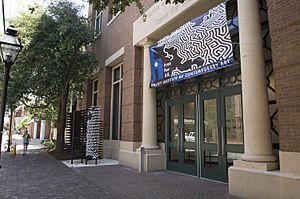Halsey Institute of Contemporary Art facts for kids
 |
|
| Former name | Halsey Gallery |
|---|---|
| Established | 1983 |
| Location | 161 Calhoun Street Charleston, South Carolina 32°47′06″N 79°56′14″W / 32.7851°N 79.9373°W |
| Type | Art Museum |
| Owner | College of Charleston |
The Halsey Institute of Contemporary Art is a cool place in Charleston, South Carolina. It's part of the College of Charleston. The Halsey shows off amazing contemporary art (art made recently). They feature new and rising artists. You can find it downtown at 161 Calhoun Street. Mark Sloan was the director for many years, until 2020. Katie Hirsch was the director from 2021 to 2024.
Besides art shows, the Halsey also has a publishing program. They host talks by visiting artists. They also have a membership program and a library. You can even watch movies there. Plus, they have programs to teach people about art.
Contents
The Halsey Institute's Story
The Halsey Institute was first called the Halsey Gallery. It was named after a talented artist named William Melton Halsey. He was from Charleston. His modern art was shown in famous museums. These included the Museum of Modern Art and the Metropolitan Museum of Art.
William Halsey was the first person to teach art at the College of Charleston. He started teaching in 1964. When he retired in 1984, the art teachers honored him. They voted to name the art gallery after him. William Halsey passed away in 1999. That same year, he won a special award called the Elizabeth O’Neill Verner Award.
Halsey’s wife, Corrie McCallum, was also an artist and teacher. She was the first to teach printmaking at the College of Charleston. She helped the Gibbes Museum of Art create an art program. This program was for public school students in Charleston County. Corrie McCallum worked at several art places. She always spoke up for visual arts. She also won the Elizabeth O’Neill Verner Award in 2003. She passed away in 2009.
Since 1984, the Halsey gallery has shown art from many artists. These artists come from the local area, across the country, and even other countries. In 2005, the gallery changed its name. It became the Halsey Institute of Contemporary Art. This new name showed all the different programs they offered.
In 2009, the Halsey Institute moved to a bigger space. It is now on the first floor of the Marion and Wayland H. Cato Jr. Center. In 2012, the South Carolina Arts Commission gave the Halsey Institute another Elizabeth O’Neill Verner Award. This award specially recognized director Mark Sloan. In 2018, Charleston's Mayor John Tecklenburg made March 14 a special day. It was named William Halsey and Corrie McCallum Day in Charleston.
What the Halsey Institute Does
Exciting Art Shows
The Halsey often shows art by new artists. They also feature artists who are in the middle of their careers. Sometimes, they even show artists who might have been "overlooked." The Halsey has put on more than 275 art shows. They have displayed works from over 2,000 artists. They often make videos that go behind the scenes. These videos help visitors understand the artist's life and how they create their art.
Artists from Around the World
The Halsey Institute often invites artists to stay and work there. This is called an "artist-in-residence" program. Artists might stay for a few weeks or even several months. During their stay, artists create new artworks right at the Halsey. These new pieces are then shown in an exhibition. The artists also meet with the local community. They give talks, lead workshops, and host other public events. Some past artists include Chen Long-bin, Eames Demetrios, Hung Liu, and Lonnie Holley.
Looking To See Tours for Students
The "Looking To See" program started in 2010. It offers free guided tours of the art shows. These tours are for students in Charleston. They are for kids from kindergarten all the way to high school. The tours are offered through after-school programs and youth groups.
Talks by Artists
When there's a new art show, the Halsey often hosts talks. Sometimes, the artist and the curator walk through the gallery. They explain the art and answer questions. Other times, the artist gives a more formal presentation. These events let the public meet the artists. It's a great chance to ask questions. You can also understand the art from the artist's point of view. The Halsey also hosts other special talks throughout the year. These are given by visiting artists or teachers from the College of Charleston.

